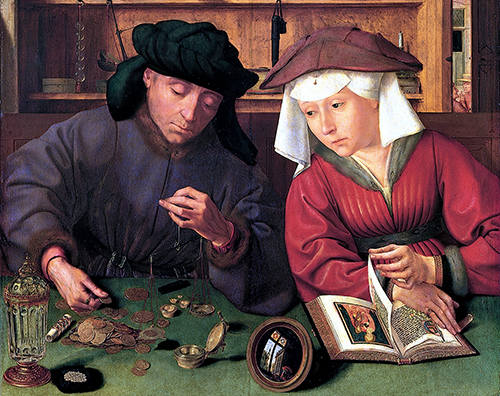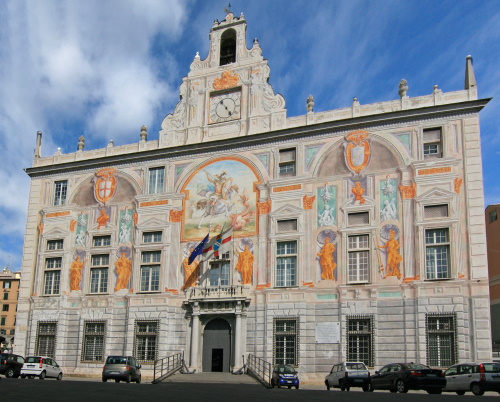
Banks appear in a number of fantasy stories. George Martin’s Iron Bank is probably the best known, but banks and banking families can be found all around the fantasy landscape, especially in modern works. For writers considering including banks and bankers in their own stories, knowing something of the history can help add detail and color.
Money Changers
Europe in the High Middle Ages, say around 1100, had a bewildering variety of coinage (see my article on medieval money), a crazy cobweb of overlapping public authority, and an unreliable network of roads. Banking arose in response to the need of merchants to conduct large-scale business at a distance in that environment.
As you might guess, with so many different coins, knowing how to convert from one currency to another was a fairly technical business. That business was handled by a money changer. In Florence and other north Italian towns, the money changers set up shop at markets and near merchant establishments—any place where there was plenty of commercial traffic. The benches they sat on are called banca in Italian. That’s where we get the term bank.
Money changers knew more than just how to convert currencies. They had scales and could weigh coins to ascertain their real value. Since they tended to have a fair amount of hard cash on hand, they naturally got into the business of making loans. They also had strongboxes and the ability to keep good records, so they became holders of deposits. A visiting merchant might rather leave his cash with a money changer than to keep it in a bag under the bed at the inn!
As with modern currency conversion, money changers charged a percentage of the transaction for their services. It was normally quite modest, only a percent or two, but it was enough to make a nice living. Even after the development of banks, money changers continued to play a role, but they tended to deal mainly with regional commerce and to lend money in small sums.
Early Banking
Since a money changer did most of the things associated with banking, it’s impossible to say precisely when or where “banking” started. In the thirteenth century, certainly. Along the northern shores of the Mediterranean, certainly, particularly in Italy and Catalonia over in modern Spain. When you hear someone say that banking started in Genoa or Barcelona, they’re speaking of a formal institution with a name and a charter. But families were doing banking all through the 1200s, and you should really think more about the family than about the bank. That is, family members and employees might have offices in several cities. In each city was the ability to raise money, keep and track money, and disburse money. The principal function was to serve the family business, but this often entailed providing financial services to partners and clients—short-term loans, for example, or keeping cash for a time until a certain transaction was completed.

We think of a bank as a building with money in it, and there were such places, at least by the 15thc. Mostly, though, were buildings owned by families and somewhere in the building would be a locked room or rooms that held locked strongboxes. If you think about it, even a modern bank is like this. The room with the money is only part of the building’s function. There are also offices for negotiating loans, one or more room for storing valuables, perhaps an investment office, and so on. But to make the modern parallel work, it would be more like each major company had its own bank, for there were very few independent banks. The ones that existed were operated by the city, such as the Bank of St George in Genoa.
The other really noticeable difference is that while banks did store currency and valuables, they didn’t pay interest on those deposits. They simply provided safe storage and good accounting. This was a vital function for long-distance trade. Ordinary folk did not put money in banks, and the bank draft (or signature cheque) had not yet been invented.
For the Fantasy Writer
We most often use banks as a convenience. We reference the thing–“We must store these jewels in a safe place. Memmius here knows a banker.” — and move on. Or, we use the bank as the target for a heist, to show off our characters’ skills, or to get them caught red-handed.
Seriously, is there any more to do than that? How interesting can banking be? George Martin does a good job here, with the Iron Bank. We don’t really learn much about banking, but he makes it a power in itself, with which other powers must deal. That was clever.
This could be done on a more local level. The Bank of Genoa, for example, was a power in the city of Genoa itself–the top families all made sure they had a seat at the Bank, and the government used it as a source of ready credit. There’s plenty of room there for some court intrigue.
Let Us Hear From You
I’m a medieval historian (does it show?), which means I don’t know much about banking outside of Europe. Do you? If so, leave a comment! Our readers would love to know more about other models for banking.
Do banks or money changers play a role in one of your stories? Have you written a fantasy bank epic? Tell us about it! Mythic Scribes is eager to hear how authors make new use of familiar things like banks.
References
- Lopez, Robert S. The Commercial Revolution of the Middle Ages. Englewood Cliffs, NJ. 1971.
- DeRoover, Raymond. Cambridge Economic History of Europe, Volume 3. Cambridge, 1963.
- Peter Spufford, Handbook of Medieval Exchange (London, 1986).
- Peter Spufford, Money & its Use in Medieval Europe.
E.L. Skip Knox is the creator of the fantasy world called Altearth, a place where magic is real, monsters roam the land, and the Roman Empire never fell.


I have money changers coming into play as the characters reach more civilized trade-based cities, and that will be good fun in the future. The next book should contain guilds and money-lenders/banks which should be good fun involving two things Mr. Knox has covered.
The interesting thing to me with coins, is that they always tended to have greater value than bullion, although this would depend on a variety of variables.
Good stuff as always
I don’t know a ton about early banking outside of Europe, but readers of this article may be interested in the idea that early currency was probably invented by the Phoenicians sometime around 1350 BCE. Phoenicia is geographically the Levant and they were heavily involved in the metals trade and centrally located.
For a social historian I know a distressing amount about economics, and yet not nearly enough by half. But here goes.
The coin thing is easy. Value was by weight. At least by the 14thc (probably before), coins were struck by stamps, sometimes driven by hand sometimes by water or wind–the stamp being a great heavy thing that the external power raised, then was dropped. The coin might go out that way or might get edges trimmed. I'm pretty sure all were weighed prior to shipping. As you might imagine, the temptation to fraud was strong, as was the temptation on the part of the lord to put in baser metals, or put in a few less grains of silver per coin. Counterfeiting was a capital crime.
Another temptation was clipping, which was exactly as it sounds. You'd clip off a narrow band, little enough so the coin would still pass without being weighed. Do that enough, had you had quite a nice pile that could be melted down for the pure silver within. Pretty much the definition of easy money!
The smooth edges of modern coins are fairly recent. 19thc? I don't do modern history. <g> But one reason for it was to discourage clipping.
As for bank notes, that goes in two directions. First, there was a thing called money of account, which has a long history and was independent from banking itself. It was a way to represent large amounts of money for large transactions. It goes at least back to Romans keeping accounts of their enormous state expenditures for grain, etc. One unit was the pound, which is libra in Latin, which is why the British pound has that L symbol. In French it's livre and in Italian and elsewhere it's lira. We get the word from German, Pfund. I'm pretty sure there are no pound coins before modern times, and mostly it was paper money. But in the Middle Ages it was a money of account. The other was the mark, which unit occurs regularly in the historical record.
There was also something called a bill of exchange, which I think is still used or was until the advent of electronic transactions. Maybe still is. The details of this are a bit complicated. Simplified, it's a letter by which a merchant in one town authorizes a representative in another town to make a payment on his behalf. These bills came to have a value in their own right and were bought and sold, usually by banks. You can read Professor Munro's lecture notes on the topic here The Medieval Bill of Exchange
I've sometimes thought there might be a fantasy analog to this–magicians authorizing the use of certain artifacts without having to travel there in person. My vision of fantasy can tend toward the mundane. <g>
hth!
Skip I always enjoy the subjects of your articles! This one (and backtracking to your money article) is timely for me as it's a part of my current WIP I am working out in the latest edits.
Two quick questions: In looking over images of old coins, some of which have been clipped, how consistent were the early coins when they were new? In other words, did they have the even, solid edges of current coins or were they a little uneven from coin to coin in minting?
Also, did early banks have any form of bank notes or coins that were made/minted solely to represent large sums of money for transfer (like the famous 100,000 bank bills of US currency?) which would have no value to anyone outside of the bank system?
Thank you for your work and research!